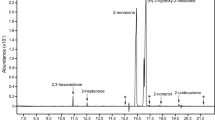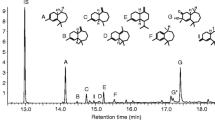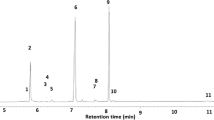Abstract
The aggregation pheromones were studied from two geographical isolates (Hakalau, Hawaii, and Silkwood, Queensland, Australia) of the New Guinea sugarcane weevil, Rhabdoscelus obscurus. Coupled gas chromatographic–electroantennographic detection (GC-EAD) and GC–mass spectrometric (MS) analyses of Porapak Q volatile extract from male and from female Hawaiian R. obscurus revealed a single EAD-active, male-specific candidate pheromone, which was identified as 2-methyl-4-octanol (1). Corresponding volatile analyses from male and from female Australian R. obscurus consistently revealed three EAD-active, male-specific candidate pheromone components that were identified as 1, (E2)-6-methyl-2-hepten-4-ol (rhynchophorol) (2), and 2-methyl-4-heptanol (3). In field experiment 1 in Hakalau, Hawaii, traps baited with a stereoisomeric mixture of synthetic 1 (3 mg/day) plus sugarcane captured more weevils than did traps baited with 1 or sugarcane alone or no bait, indicating that 1 is the pheromone of the Hawaiian R. obscurus population. In field experiment 2, conducted in Silkwood, Australia, traps baited with stereoisomeric mixtures of synthetic 1, 2, and 3 (3 mg/day each) plus sugarcane caught more weevils than did unbaited traps or traps baited with 1, 2, and 3 or sugarcane. Testing candidate pheromone components 1, 2, and 3 in experiments 2–5 in all possible binary, ternary, and quaternary combinations with sugarcane, indicated that 1 and 2 in combination, but not singly, are pheromone components of the Australian R. obscurus population. Weevils from several locations in Australia and Hawaii could not be differentiated using traditional morphological characters or ultrastructural comparisons with scanning electron microscopy (SEM). However, comparisons of mtDNA sequences (cytochrome oxidase I; regions I1 to M4; 201 base pairs) revealed 5.5% variation between the Hawaiian (N = 2) and the Australian (N = 4) samples. There was no intrapopulation variation in sequence data from the weevils from Hawaii versus Australia, suggesting that they are sibling species.
Similar content being viewed by others
REFERENCES
Arn, H., Stadler, E., and Rauscher, S. 1975. The electroantennographic detector—A selective and sensitive tool in the gas chromatographic analysis of insect pheromones. Z. Naturforsch. 30C:722–725.
Chang, V. C. S., and Curtis, G. A. 1972. Pheromone production by the New Guinea sugarcane weevil. Environ. Entomol. 1:476–481.
Chang, V. C. S., Curtis, G. A., and Ota, A. K. 1971. Insects. Hawaiian Sugar Planters' Association Annual Report, pp. 43–44.
Crespi, B. J., Carmean, D., Mound, L. A., Worobey, M., and Morris, D. 1997. Phylogenetics of social evolution in Australian gall-forming thrips: Evidence from mitochondrial DNA sequence, adult morphology, and gall morphology. Mol. Phylogenet. Evol. 9:163–180.
Giblin-Davis, R. M., PeÑa, J. E., and Duncan, R. E. 1994a. Lethal trap for evaluation of semiochemical mediated attraction of Metamasius hemipterus sericeus (Olivier) (Coleoptera: Curculionidae). Fl. Entomol. 77:247–255.
Giblin-Davis, R. M., Weissling, T. J., Oehlschlager, A. C., and Gonzalez, L. M. 1994b. Field response of Rhynchophorus cruentatus (F.) (Coleoptera: Curculionidae) to its aggregation pheromone and fermenting plant volatiles. Fl. Entomol. 77:164–177.
Giblin-Davis, R. M., Gries, R., Gries, G., Pe Ña-Rojas, E., PinzÓn, I., PeÑa, J. E., Perez, A. L., Pierce, H. D., Jr., and Oehlschlager, A. C. 1997. Aggregation pheromone of palm weevil, Dynamics borassi. J. Chem. Ecol. 23:2287–2297.
Giblin-Davis, R. M., Oehlschlager, A. C., Perez, A. L., Gries, G., Gries, R., Weissling, T. J., Chinchilla, C. M., PeÑa, J. E., Hallet, R. H., Pierce, H. D., JR., and Gonzalez, L. M. 1996. Chemical and behavioral ecology of palm weevils (Curculionidae: Rhynchophorinae). Fl. Entomol. 79:153–167.
Halfpapp, K. H., and Storey, R. I. 1991. Cane weevil borer, Rhabdoscelus obscurus (Coleoptera: Curculionidae), a pest of palms in Northern Queensland, Australia. Principes 35:199–207.
Lunt, D. H., Zhang, D.-X., Szymura, J. M., and Hewitt, G. M. 1996. The insect cytochrome oxidase I gene: Evolutionary patterns and conserved primers for phylogenetic studies. Insect Mol. Biol. 5:153–165.
Napompeth, B., Nishida, T., and Mitchell, W. C. 1972. Biology and rearing methods of the New Guinea sugarcane weevil, Rhabdoscelus obscurus. Hawaii Agricultural Experiment Station College of Tropical Agriculture, University of Hawaii Technical Bulletin No. 85.
Oehlschlager, A. C., Pierce, A. M., Pierce, H. D., JR., and Borden, J. H. 1988. Chemical communication in cucujid grain beetles. J. Chem. Ecol. 14:2071–2098.
Oehlschlager, A. C., Pierce, H. D., JR., Morgan, B., Wimalaratne, P. D. C., Slessor, K. N., King, G. G. S., Gries, G., Gries, R., Borden, J. H., Jiron, L. F., Chinchilla, C. M., and Mexzan, R. G. 1992. Chirality and field activity of Rhynchophorol, the aggregation pheromone of the American palm weevil. Naturwissenschaften 79:134–135.
Oromi, J. C., and Hewitt, G. M. 1995. Mitochondrial DNA phylogeny and sequential colonization of Canary Islands by darkling beetles of the genus Pimelia (Tenebrionidae). Proc. R. Soc. London B 261:173–180.
Oromi, J. C., and Hewitt, G. M. 1996. Phylogeny of the genus Hegeter (Tenebrionidae, Coleoptera) and its colonization of the Canary Islands deduced from cytochrome oxidase I mitochondrial DNA sequence. Heredity 76:392–403.
Perez, A. L., Campos, Y., Chinchilla, C. M., Oehlschlager, A. C., Gries, G., Gries, R., Giblindavis, R. M., Castrillo, G., PeÑa, J. E., Duncan, R. E., Gonzalez, L. M., Pierce, H. D., JR., Mcdonald, R., and Andrade, R. 1997. Aggregation pheromones and host kairomones of the West Indian sugarcane weevil, Metamasius hemipterus sericeus. J. Chem. Ecol. 23:869–888.
Ramirez-Lucas, P., Malosse, C., Ducrot, P. H., Lettere, M., and Zagatti, P. 1996a. Chemical identification, electrophysiological and behavioral activities of the pheromone of Metamasius hemipterus (Coleoptera: Curculionidae). Bioorg. Med. Chem. 4:323–368.
Ramirez-Lucas, P., Rochat, D., and Zagatti, P. 1996b. Field trapping of Metamasius hemipterus with synthetic aggregation pheromone. Entomol. Exp. Appl. 80:453–460.
Rochat, D., Malosse, C., Lettere, M., Ducrot, P. H., Zagatti, P., Renou, M., and Descoins, C. 1991. Male-produced aggregation pheromone of the American palm weevil, Rhynchophorus palmarum (L.) (Coleoptera: Curculionidae): Collection, identification, electrophysiological activity, and laboratory bioassay. J. Chem. Ecol. 17:2127–2140.
SAS Institute. 1985. SAS user's guide: Statistics, 5th ed. SAS Institute, Cary, North Carolina.
Van Zwaluwenburg, R. H. 1938. Trapping sugar cane beetle borers at Kaila. Hawaii. Planter's Rec. 42:167–173.
Zimmerman, E. C. 1993. Australian weevils (Coleoptera: Curculionoidea). Volume III. Nanophyidae, Rhynchophoridae, Erirhinidae, Curculionidae: Amycterinae, literature consulted. CSIRO Australia and Entomological Society of America Publishing.
Author information
Authors and Affiliations
Rights and permissions
About this article
Cite this article
Giblin-Davis, R.M., Gries, R., Crespi, B. et al. Aggregation Pheromones of Two Geographical Isolates of the New Guinea Sugarcane Weevil, Rhabdoscelus obscurus. J Chem Ecol 26, 2763–2780 (2000). https://doi.org/10.1023/A:1026437809875
Issue Date:
DOI: https://doi.org/10.1023/A:1026437809875




